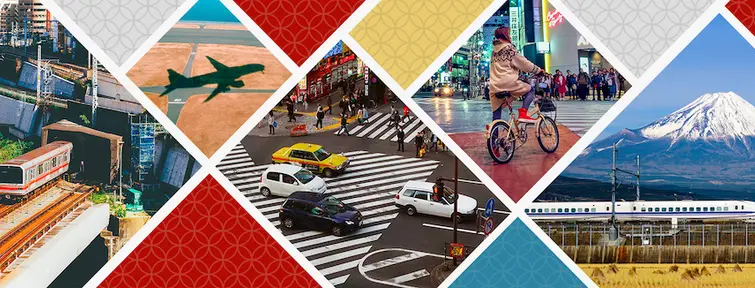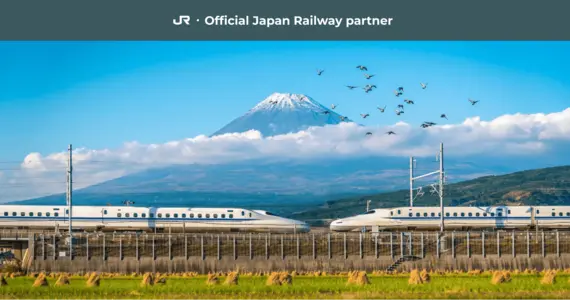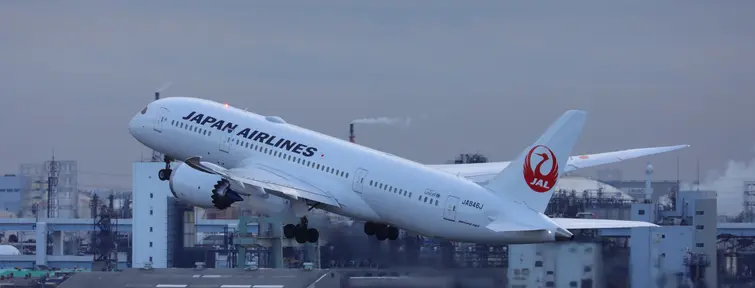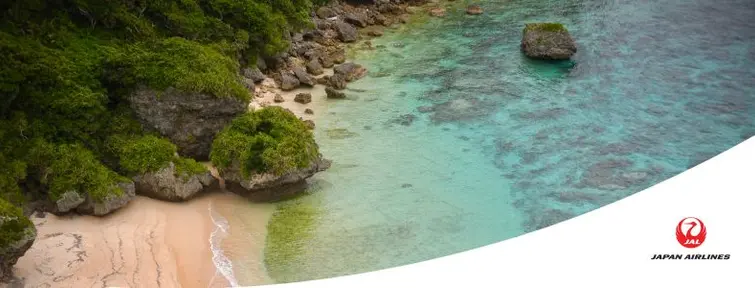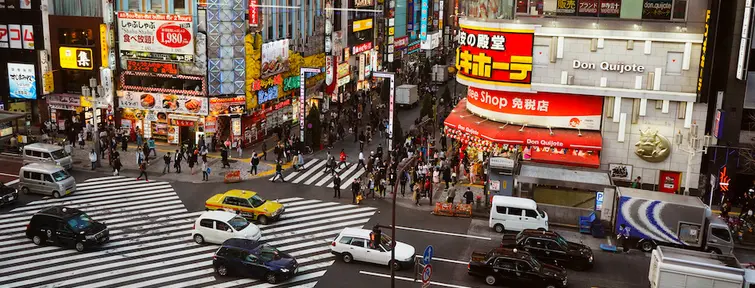Getting around in Japan
How to travel in Japan
A practical guide to Japanese transport to discover Japan from the inside
You've decided to travel to Japan and are in the process of creating your itinerary?
What to see in Japan? How to get there? The Japan Experience team is here to answer your questions and advise you on how to organize a trip to Japan that suits you and your needs!
Trains in Japan
Japan's rail network is as modern as it is efficient, making trains the easiest way to get around the country. Japan's high-speed train, the Shinkansen, will get you to the four corners of the archipelago in record time. And local lines are no match for this state-of-the-art train: their punctuality and quality make Japan's rail system one of the best in the world!
A little tip: one of the tools you can use to create your itinerary when traveling by train in the archipelago is Hyperdia, the indispensable application for traveling in Japan.
Discover our practical guide: Taking the train in Japan
For unlimited train travel and complete freedom, consider the Japan Rail Pass! You can discover the whole archipelago with a national JR Pass, or explore a region in depth with one of the regional JR Passes. These train passes give you unlimited access to all or part of the Japan Rail ways network for several consecutive days.
Where can I buy a Japan Rail Pass? The Japan Experience boutique at 30 rue Sainte-Anne in the 1st arrondissement of Paris is open Monday to Saturday from 10am to 7pm. Our advisors are on hand to discuss your itinerary and the best transport solutions for your trip.
JRP Assistance, your safe train journey
Subways in Japan
Japan's major cities have modern, efficient, safe and cost-effective subway networks. These subway systems enable you to get around quickly in the city centers of Tokyo, Osaka, Nagoya and elsewhere. Japanese subway stations feature explanatory signs and directions in English. Most subways have announcements in English on the platforms and in the carriages.
If you're visiting Tokyo, taking the subway is a must. The city is so vast that cycling, walking and even the bus are not enough to discover the world's largest megalopolis. With the famous circular Yamanote Line (a little bonus, it's accessible with the Japan Rail Pass!) and numerous other private lines, Tokyo is one of the best served cities in the world.
To find out more :
Flying to Japan
External flights - Flying to Japan
There's only one way to get to Japan: by plane. There are several airports in Japan with international flights, and the first step in organizing your trip is to decide where you want to land:
- Narita airport , some 60 km from central Tokyo, is the main gateway for travellers arriving in Japan
- Haneda airport is in the heart of the Japanese capital, built on an artificial island in Tokyo Bay
- The city of Nagoya in central Japan is home to Chûbu International Airport.
- Kansai airport, on Osaka Bay, offers easy access to Kyoto on arrival in Japan.
- Nagasaki airport, on the island of Kyushu, is the southernmost airport in the Japanese archipelago, and continues the city's international tradition.
Of these airports, only the two in Tokyo and the one in Kansai (called KIX) welcome direct flights from France. Other Japanese airports offer a few international flights, but mainly to Korea and China.
For a direct flight from Paris to Tokyo, allow between 11 and 13 hours in the air. Between France and Japan, direct flights are offered by Air France, Japan Airlines (JAL) and All Nippon Airways (ANA).
If you have a smaller budget or are traveling at peak times, other airlines offer flights with stopovers, often in Europe (London, Frankfurt or Helsinki, for example), the Middle East or Asia.
With a stopover, the total journey takes between 16 and 18 hours on average.
Japan Experience's little extra: Soon, one of our Travel Angels will be able to pick you up at Tokyo airport, so that you're taken care of as soon as you arrive in Japan, and can start your stay with complete peace of mind!
Internal flights - Travel around Japan by plane (discover the JAL Japan Explorer Pass)
There are many internal flights between Japan's major cities. With numerous airports scattered throughout the archipelago, domestic flights can be a real alternative to the train for visiting remote areas of Japan, even if you're only in Japan for a short time.
In addition to the airports of Tokyo, Nagoya and Osaka, you can land at the four corners of Japan: Hiroshima, Sendai, Sapporo, Kumamoto, Fukuoka and Okinawa are just a few hours' flight away!
The Japanese domestic air transport market is dominated by Japan Airlines (JAL) and All Nippon Airways (ANA), but you can also find smaller companies like Air Do, StarFlyer, Peach Aviation, Jetstar Japan or Vanilla Air for lower prices.
The JAL Japan Explorer Pass, Japan Airlines' low-cost option for domestic flights!
Starting at 5,500 JPY, the JAL Japan Explorer Pass allows you save money on tickets for domestic flights within Japan, departing from the archipelago's main cities. In total, over 30 destinations are available through the various pass options available, up to 11,000 JPY! Air fares are already competitive with train fares, so with the JAL Japan Explorer Pass, the whole country is at your fingertips. Even flights to the paradise archipelago of Okinawa, and ultra-local flights to the islands of Ishigaki, Miyako and Kumejima. Japan's most beautiful destinations await you. On domestic flights, with the JAL Japan Explorer Pass, you benefit from free WiFi on board, and comfortable economy class.
To find out more :
Cycling in Japan
As an alternative to walking, bicycles allow you to venture into the back alleys of Japan's megacities and get off the beaten track with a twist of the handlebars! Visit the tourist offices of the cities you're visiting, most of which offer free or very inexpensive bicycle rental systems.
Cycling also makes it possible for everyone to discoverrural Japan. Stroll through the rice paddies and mountains of the Japanese countryside for a timeless getaway.
Discover our guided bike tours in Japan with our Travel Angels:
To find out more :
- Shodoshima by bike
- Shimanami Kaido cycle path
- Cycling around Tokyo
- Visit Osaka by bike
- Hiroshima by bike
- Rent a bike in Kyoto
Buses in Japan
Local short-distance buses
The bus is the predominant means of transport in rural Japan and in the vast majority of Japanese cities, such as Kyoto. Using buses in Japan can be intimidating, as ticket sales systems vary according to the companies running the routes, and many buses have little or no information in English when you're away from the most touristy areas. They are, however, indispensable for visiting Japan!
However, their systems are fairly uniform throughout Japan: you can't usually buy a ticket in advance, and you'll need to bring some change with you, as you'll need to have some extra money to pay for your journey. Alternatively, you can use a prepaid Suica or Pasmo card to travel on most bus routes in Japan.
How do I take the bus in Japan?
Some bus routes have a fixed fare, but most depend on the distance traveled. The fare is determined by a ticket you take when you enter the bus, indicating the station where you got on and an associated number(if you're using a Suica or Pasmo, just page your card). A display above the driver indicates the next stop and the corresponding fares for those alighting there. To determine your fare, match your ticket number with the fare shown on the display. Payment is made as you exit the bus, by putting your ticket and the exact fare into the machine installed next to the driver(with a prepaid travel card, just tap it on the reader next to it).
The process sounds complicated, but it's actually quite simple and instinctive! You can also find out the price of your journey in advance using applications such as Google Maps or Hyperdia, so you can take the bus prepared and relaxed.
Long-distance buses
There are also city-to-city buses throughout the archipelago. Although slower than express trains, these "kôsoku" buses are an inexpensive alternative for long- and medium-distance travel in Japan. In fact, they're THE low-cost way to travel the length and breadth of Japan!
Japan has a dense network ofhighway bus lines, operating day and night. They are often quite pleasant, with comfortable, reclining seats and Wi-Fi access for all passengers.
Most bus companies do not offer ticket purchase interfaces in English, and these can be difficult to use for non-Japanese speakers.
Some, however, have opened up to the international tourism market:
- Willer Express offers online reservations in English
- Japan Railways bus tickets can be purchased at many JR stations in Japan. Note that some local JR bus lines (not express buses) are accessible with the Japan Rail Pass
To go further :
The car in Japan
As an alternative to the train, traveling by car in Japan gives you incomparable freedom and lets you see Japan from the inside. Explore rural Japan and stop whenever and wherever you like with your car to discover a side of Japan still unknown to many travelers!
It's the ideal solution for a stay in Japan with a small group, family or friends. Less expensive than train travel, you can travel at your own pace without worrying about rush hours and train schedules. And for busy travelers, having your own car means you can take all your luggage with you!
Some of our Japan tours include discovery itineraries by car:
Discover our practical guide: Driving in Japan
Rent a car in Japan made easy with our car rental offer in partnership with Nissan. At the same time, we can translate your driver's license, which is essential for French people to be able to drive in Japan!
Japan Experience's little plus: our service gives you unlimited access to a telephone assistance service in Japan, 7 days a week, from 9 a.m. to 6 p.m., for the duration of your rental. Choose the"Drivin' Assistance" option when you rent a vehicle with us and our team will be there to answer your questions and advise you around your car trip to Japan.
To find out more :
Boating in Japan
Made up of several thousand islands, Japan is naturally home to a vast network of sea routes, both commercial and tourist. And while Japan's four main islands (Hokkaido, Honshu, Shikoku and Kyushu) are linked by bridges and tunnels, many smaller islands are only accessible by boat, and have no airports either.
Here are just a few examples of places you can explore by boat:
- The Seto Inland Sea and its many islands, such as Shodoshima, Naoshima and Teshima, famous for the Setouchi Triennale contemporary art festival
- Sado Island, also known as Sadoshima, some 50 kilometers off the coast of Niigata Prefecture, where you can enjoy magnificent hiking trails
- The islands off Tokyo, such as Niijima Island and Shikinejima Island, for a break from the hustle and bustle of Tokyo
- The many islands that make up the Okinawa archipelago, for a relaxing break under the tropical sun of Japan's southernmost point
These long- and short-distance ferries can also be a great way of getting from island to island when you opt for the car as your main means of transport! In fact, most ferries take passengers on board, as well as bicycles and motor vehicles.
To find out more :
- Getting around by boat and ferry
- Visit Tokyo by waterbus
- Tokyo Cruise's "Asakusa-Hinode Pier" cruise
- Tokyo's yakatabune
- Sky Duck, half-bus and half-boat
- Hozu / Hozugawa Kudari river trip
